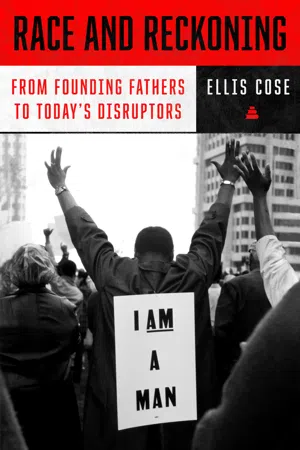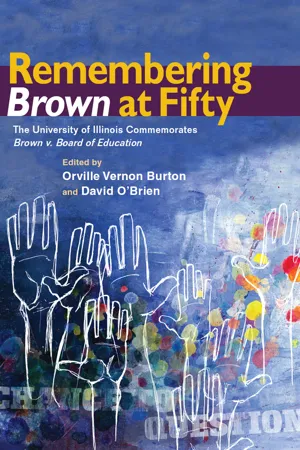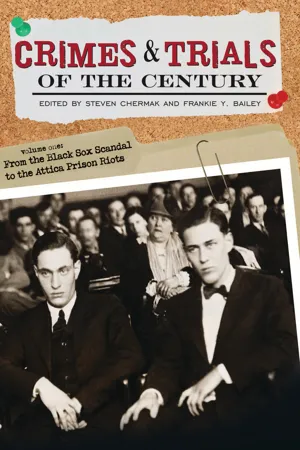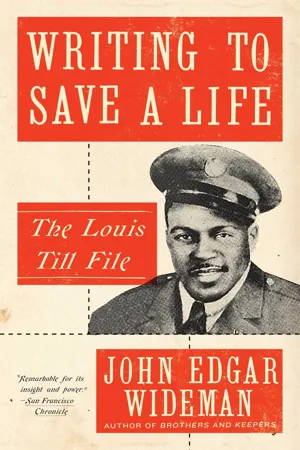History
Emmett Till
Emmett Till was a 14-year-old African American boy who was brutally murdered in Mississippi in 1955 after being accused of whistling at a white woman. His death became a catalyst for the civil rights movement, as the open casket funeral and the acquittal of his killers highlighted the deep-seated racism and injustice in the United States. Till's story continues to symbolize the struggle for racial equality.
Written by Perlego with AI-assistance
Related key terms
1 of 5
6 Key excerpts on "Emmett Till"
- eBook - ePub
Race and Reckoning
From Founding Fathers to Today’s Disruptors
- Ellis Cose(Author)
- 2022(Publication Date)
- Amistad(Publisher)
10Rage, Resistance, and the Politics of Resentment
From the mid-1950s to the late 1960s, the United States was a boiling cauldron of racial chaos, with hope, despair, progress, and hate boiling over almost daily. It was a period during which much of White America was forced to concede what Blacks and other people of color had known all along: that its customary treatment of more than one tenth of its population was not just immoral but foolish. During the period between the murder of Emmett Till and the assassination of Martin Luther King, Jr., most Americans accepted (grudgingly, in many cases) that the country was inexorably changing.Emmett Till was not the first young Black man to be murdered on suspicion of flirting with a White woman. Nor was he the only innocent victim of racially motivated torture. But his death in August 1955 ignited outrage that persists to this day—in part because his mother invited the world to bear witness to what bigoty had done to her son.For his alleged act of interracial disrespect, Till was kidnapped, stripped, mutilated, murdered, and tossed into Mississippi’s Tallahatchie River. His mother, Mamie Elizabeth Till-Mobley, insisted on an open casket at her son’s funeral. “Let the people see what they did to my boy,” she insisted. And her boy received a sendoff worthy of a head of state. According to the Chicago Defender, more than fifty thousand mourners visited the funeral home to pay homage as his body lay in state. Throughout the night people came, forming lines stretching around the block.Roberts Temple Church of God in Christ, where the service was held, could hold only two thousand. Several thousand more listened to the service over a public address system. Inside, according to the Pittsburgh Courier, “One woman fainted at the sight of Emmett’s battered remains. Others broke [into] loud and piercing, screaming sobs.”The Defender - eBook - ePub
Remembering Brown at Fifty
The University of Illinois Commemorates Brown v. Board of Education
- Orville Vernon Burton, David O'Brien, Orville Vernon Burton, David O'Brien(Authors)
- 2022(Publication Date)
- University of Illinois Press(Publisher)
Defender. They saw the picture. They were horrified. They felt vulnerable. For at least a generation, black kids were exposed to the Emmett Till story in what would become a rite of passage. They were deeply moved by it.It stripped them of the protection of their childhood. That sense of innocence. For so many the story of Emmett Till became the introduction to race relations in America. Little black kids have grown up learning that there are people out there—white people—who can cause them harm, kill them, for no other reason than the color of their skin. There would no longer be a safe place to hide from a dangerous reality—and a realization. Everybody had to take responsibility for what we had become. Anyone who had done anything to cause the problem. Anyone who had done nothing to stop it from happening.There no longer could be any innocent bystanders. For an entire nation, the murder of Emmett Till marked the death of innocence.So, Brown redefined the legal relationships between blacks and whites. Emmett’s lynching moved people to want to fight for the change promised by Brown. And Montgomery provided the strategy of nonviolent, public demonstrations and boycotts.The rights … the motivation … the plan.And so many of those kids who had been Emmett’s age when he was killed and who were moved by that event, became involved in the civil rights movement when they came of age. It was a movement, after all, that was characterized by its youth. Foot soldiers. And later leaders and activists in social service and in politics and business.There were other effects.NAACP recruitment and fundraising. In the year after Emmett’s murder, membership and contributions spiked. I saw a report indicating that the organization took in roughly two hundred and fifty thousand dollars that year. A considerable increase. For a short period, Mother Mobley was out on a lecture tour supported by the NAACP, and she would address crowds and churches and rallies where thousands of people would fill barrels and trash cans with what they called “fighting dollars” for the NAACP. - eBook - PDF
Crimes and Trials of the Century
2 volumes [2 volumes]
- Frankie Y. Bailey, Steven Chermak Ph.D., Frankie Y. Bailey, Steven Chermak Ph.D.(Authors)
- 2007(Publication Date)
- Greenwood(Publisher)
• David Jackson, photographer for Ebony and Jet magazines, took the photograph of Emmett Till in his coffin that shocked the nation; the photograph appeared in Jet magazine. Till violated the most sacrosanct category of black behavior toward whites: he did not show respect to a white woman. In the Look magazine interview, Milam claimed that he and Bryant only wanted to scare Till, but Till refused to acknowledge his transgression against Bryant’s wife, and he would not even beg for mercy. Operating within a suprema- cist mind-set, the men felt that they had no other choice but to kill Till. An all-male, all- white-supremacist court of law justified their action when they voiced the words not guilty. Southern Violence, National Involvement Emmett Till returned to Chicago by train—not as the young man returning home from a visit to relatives in the South—but as a body in a wooden casket bearing an order to remain sealed. His mother’s insistence to open that casket at the railroad station in Chi- cago sparked the civil rights movement, and when Jet magazine released the photograph of Till’s body, it spotlighted the violence that blacks in the South suffered. Till’s death focused national attention on American racial inequality that ultimately led to the passage of the Civil Rights Act in 1964 and the Voting Rights Act in 1965 (Crowe, 2003). The civil rights movement also elevated black consciousness and racial pride. Popular Culture Till’s murder inspired numerous songs, poems, essays, and novels by both famous artists and amateurs, who submitted their entries to local newspapers. Popular songwrit- ers Bob Dylan and Pete Seeger, poet Langston Hughes, authors Toni Morrison and Lewis Nordan, and actors and producers Ossie Davis and Ruby Dee are among the famous artists who memorialized Emmett Till. Chris Crowe’s (2002) book Mississippi Trial, 1955 blends history and fiction, in which his protagonist determinedly tries to solve the murder. - eBook - PDF
Writing the Visual
A Practical Guide for Teachers of Composition and Communication
- Carol David, Anne R. Richards(Authors)
- 2008(Publication Date)
- Parlor Press, LLC(Publisher)
Jane Davis 106 tions to open the window on the past so that we can learn from it in order to improve the present and the future. This essay examines aspects of the historical, societal, theoretical, and pedagogical issues which are manifested in the murder of Em-mett Till and its aftermath. Anne Moody recounts in Coming of Age in Mississippi how hearing of Emmett’s murder introduced into her young life the fear and hatred of whites who could kill another teen-ager. Moody describes the dread that she and her peers, as well as other blacks, felt when acknowledging that they might become victims of such shocking violence. My own interest in the event was sparked when, as a child, I experienced the horror of seeing a reprint of the Jet photographs. While viewing Eyes on the Prize two decades later, I be-came convinced of the need for more people to know about this mur-der. I have shown the video and discussed the event in writing classes and have heard my students of various races use the video as a frame-work for reflecting honestly on past and present race relations. Visual media have had a tremendous impact on me as a person and educator, as well as on my students, and nowhere more so than in the retelling of Emmett’s story and in the analysis of what that story has to say to us, today, about terror and compassion. His continued relevance is evident in the fact that in June 2007, after hearings that included the subcom-mittee on Crime, Terrorism and Homeland Security, the House of Representatives passed the Emmett Till Unsolved Civil Rights Crime Act by a vote of 422 to 2. - eBook - ePub
Writing to Save a Life
The Louis Till File
- John Edgar Wideman(Author)
- 2016(Publication Date)
- Scribner(Publisher)
Just in case you don’t recall, I’ll remind you that in 1955, Emmett Till, also age fourteen, boarded a train in Chicago to visit family in Mississippi. A few weeks later a train brought his dead body back to Chicago. Emmett Louis Till had been murdered because he was a colored boy and had allegedly wolf-whistled a white lady.* * *Over half a century later, I’m still dealing with the faces of Clement and Till. To provide background for a fiction I intended to write about Emmett Till, I saved excerpts from newspaper coverage of the trial of Till’s murderers.Over sixty newspapers on hand in 1955 for the Sumner, Mississippi, trial. Thirty photographers popping flashbulbs, seventy reporters pecking away at truth on their typewriters. I was a bit surprised by how much national and international attention the trial had attracted. Not surprised to learn public interest had rapidly evaporated. Today Emmett Till is generally viewed as a civil rights martyr, but the shabby trial that exonerated his killers, and the crucial role played by Till’s father in the trial have largely disappeared from the public’s imagination. Silenced, the Till trial serves as an unacknowledged, abiding precedent. Again and again in courtrooms across America, killers are released as if colored lives they have snatched away do not matter.. . . the day opened hot and humid, the heat rising to an almost unbearable 95 degrees. (Chicago Defender ). . . townspeople of Sumner have never seen anything like it here—the crowds, the out-of-state newsmen and the excitement of a big trial—not even on Saturdays or when merchants conduct a drawing to give away an automobile . . . Citizens estimated as many as a thousand outsiders came, more than on the biggest trade days . . . a porter kept busy passing a pitcher of ice water to trial officials. Downstairs, a cold drink stand had its biggest day in history. (Memphis Commercial Appeal )Twenty-two seats were provided inside the rail for white newsmen where they could easily hear the proceedings . . . Negro press . . . limited to four seats directly behind the rail where the public is seated. (Chicago Defender - eBook - ePub
Emmett Till in Literary Memory and Imagination
New and Selected Poems
- Harriet Pollack, Christopher Metress, Harriet Pollack, Christopher Metress(Authors)
- 2008(Publication Date)
- LSU Press(Publisher)
THE MURDER OF Emmett Till IN THE MELODRAMATIC IMAGINATION
William Bradford Huie and Vin Packer in the 1950sSHARON MONTEITHIf the facts as stated in the Look magazine account of the Till affair are correct, this remains: two adults, armed, in the dark, kidnap a fourteen-year-old boy and take him away to frighten him. Instead of which, the fourteen-year-old boy not only refuses to be frightened, but, unarmed, alone, in the dark, so frightens the two armed adults that they must destroy him.—WILLIAM FAULKNER , “On Fear” (1956)Anything that comes out of the South is going to be called grotesque by the Northern reader, unless it is grotesque, in which case it is going to be called realistic.—FLANNERY O’CONNOR, “Some Aspects of the Grotesque in Southern Fiction,” in Mystery and Manners (1961)Emmett Till was murdered in 1955 just three months after Brown II mandated that schools should be integrated “with all deliberate speed,” a contradictory statement that could be read by the white segregationist South as license to stall integration indefinitely. The phrase itself was imbued with a tinge of melodrama—occurring as it does in Sir Walter Scott’s popular novel Rob Roy (1817), in which a lawsuit suffers interminable delays—and the trial of Till’s killers was, like the Brown v. Board of Education ruling, a focal event for segregationists who harnessed the state apparatus to ensure that post-Brown retaliatory violence would receive public approbation. When the verdict was announced in Sumner, Mississippi, on September 23, 1955, and Till’s self-confessed abductors were absolved of his murder, northern journalists dubbed the day “Black Friday,” a direct counter to “Black Monday,” the anti-Brown epithet for the day of the school decision.Following the original Brown decision of May 17, 1954, the National Association for the Advancement of Colored People (NAACP) had filed petitions to desegregate schools across some 170 school boards in seventeen states. Early resistance to school desegregation was embodied by the Citizens’ Councils, the first of which was formed in July 1954 in Sunflower County in the Mississippi Delta, precisely where Till’s murder would take place a year later. In turn, the councils were aided by the Mississippi State Sovereignty Commission, created in 1956 to prevent federal encroachment on states’ rights and to spy on anyone deviating from the segregated norm as underlined by local law and the Ku Klux Klan. According to historian Numan V. Bartley, in the year separating the two Brown decisions, “the Deep South sank deeper into hysterical reaction, while border states cemented their psychological identification with the nation, and the peripheral South, like an unstable planet, swayed between the magnetic attraction of North and South. And the long hot summer of 1955 lay ahead” (81).1 One of the effects of the “hysterical” reaction to Brown was that in the Deep South and, specifically, Mississippi—where the volume of lynchings had led to the state’s reputation as “the land of the tree and the home of the grave”—racist violence became more covert as small bands of white men on nighttime raids superseded public lynching parties. As that summer waned, one race crime would become the “inside story” of vigilante “justice” and would contain all the ingredients of a shocking and lurid thriller, so much so that the three Delta counties around which Till’s killers apparently roamed on the night of his murder would become known as “Till Country” or “Terror Country” (Levine, 93–95).2
Index pages curate the most relevant extracts from our library of academic textbooks. They’ve been created using an in-house natural language model (NLM), each adding context and meaning to key research topics.





